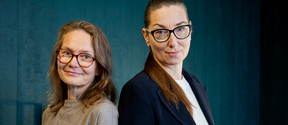A sport for gentleman thugs

Eduardo Anaya was surprised to run into familiar faces from rugby practice at his workplace. ‘Wow, you work here, too!’ Anaya said to Christopher Jonkergouw. Unbeknownst to each other, they had been toiling away in neighbouring rooms at Otaniemi.
Both play for Espoo Rugby Club. A third player, Ivan Vujaklija, likewise turned out to be an Aalto colleague when the men got chatting in training.
Anaya is a chemist and Jonkergouw a bioscientist. Postdoctoral researcher Eduardo Anaya is focusing on a cellulosic materials, which self-sterilise with the aid of sunlight, while doctoral researcher Christopher Jonkergouw is studying treatment methods for antibiotic-resistant bacteria.
Professor Ivan Vujaklija’s research deals with medical technology. He develops technical solutions that aid people who have lost a limb. For example, he has studied how prosthetics can be controlled by electrical signals generated by the muscles and nerves of the user.
They are researchers by day, but, in the evenings a few times a week, they turn into wet, muddy men whose only objective is to get the ball across the opponent’s try line and ground it – working together as a team.

There are thirty players on the pitch, fifteen on each side. Some are big and burly, others more like sprinters. Some are tall, others short. Their knees are muddy, the arms bruised. The corner of someone’s eye is beginning to swell. Their breath is steamy in the Finnish spring.
A player stands outside the pitch and raises the ovoid over his head and soon throws it in. The moment the ball leaves his powerful hands, a man pounces from amidst the players. He bends his knees and, with assistance from two teammates, soars upwards. His head almost reaches three metres. The hands of top professionals can reach above four metres. The ball flies into the hands of the highest jumper, the battle for points continues.
A position for any body
Eduardo Anaya started playing rugby when he was twelve. Between the ages 14 and 21, he played in the Spanish national team. He finds rugby fascinating because it suits players of all sizes.
‘Whether you are big or small, there’s always a position for you in rugby,’ Anaya says.
A player’s physique helps to determine his position. Smaller players are the backs. They carry and pass the ball, benefiting from being fast and agile.
Bulky and strong players, the forwards, are needed for situations that call for contact, such as when eight of the largest team members pack closely together for the scrum, which happens when play is restarted after a technical fault.
Two tightly-packed fronts shove into each other while the players try to reach the ball with their feet to kick it to their own side. The ball is in open play only after it passes out of the scrum.
The efforts of individual players matter, but the outcome is decided by how well the eight men together manage to control the movement of their group. Technique and trust are instrumental to success. Each player must trust his teammates to do exactly what was set out in the game plan.

A social game
Ivan Vujaklija started the sport ten years ago, taking the occasional break from playing in between. He has moved often because of his research work: first from his homeland Serbia to Germany, then from there to Austria, and most recently to Finland. When relocating to a new country, he has always sought out and joined a local team. Rugby introduces you to people and the community.
Both Vujaklija and Jonkergouw emphasise the sport’s encouraging atmosphere.
‘The players develop a bond that I feel is absent in other team sports,’ Vujaklija says.
Rugby is sometimes described as a game suited for gentleman thugs. The referee’s word is law during a match, players must restrain themselves even if they disagree with a ruling and only the team’s captain is allowed to speak with the referee.
Chris Jonkergouw has played for four years. The game won him over after he moved from Holland to Wales. The sport is demanding, but fair. After a match, players line up to pay their respects to their opponents. The hundred-kilo prop who just tackled you is suddenly your friend. Many play rugby because of the game’s social nature.
‘After the game, we’ll grab a beer with the rival team.’

Demands focus
The team trains twice a week from April to September, for two hours each time. In winter, players maintain their fitness at the outdoor gym. Being fit boosts performance and protects from injury.
The risk of injury is nevertheless high. The sport involves physical contact both with your own teammates and the opponents. The physical effort required involves, for example, each player falling down or colliding with another every second minute on average over the course of an 80-minute match. Their hearts race, reaching rates of up to 200 bpm.
The many positions and roles in a rugby team call for players with very different physical and technical attributes. The professional duties of these Aalto players require similar versatility.
‘The members of a research group also have their own specialised roles. The aim of our research project is commercialisation, and the group consists of both researchers and experts engaged in the drafting of business plans,’ Jonkergouw says.
Yet all belong to the same team. The laws of rugby state that the ball can only be passed backwards. For this to happen, the team must act seamlessly as one, a single player going it alone cannot accomplish much. Only when they act as one unified team can players move the ball towards the opponent’s try line and eventually win the game.

Perseverance and willpower
Research work demands perseverance and can, at times, be frustrating: you can’t just stroll into the lab and assume that everything will work as expected. Research is a process of trial and error.
Perseverance is also required in rugby.
‘You need guts to keep picking yourself up off a wet, cold and muddy pitch. And you can’t give up before you reach the desired result,’ Anaya says.
Eduardo Anaya does not play at the moment because he serves as the team’s coach. Anaya believes he can draw a lot of learning from coaching to benefit his academic career, as it involves leading his own research group.
‘The game or, similarly, research is not only about ability or planification. Endurance and commitment to reach objectives is what gives you that last push to success.’
As a researcher, you need to learn to enjoy the small moments. Funding applications are extensive and can have low success rates and not every article you submit to a scientific journal gets published. Researchers need to find joy in successful laboratory experiments, the launch of new projects or getting to guide a student with an interesting project.
The same applies in sports. If you only enjoy a sport when you win, you’ll be disappointed half the time. You also need to find energy to train even when you don’t feel like it.
‘A player needs to draw satisfaction from minor successes, such as a well-executed tackle or snatching the ball from your opponent,’ Anaya says.
Mutual trust
Professor Ivan Vujaklija has been heading research projects for a few years. As group leader, he needs to trust the team’s other researchers and that they in turn have faith in him.
The same feeling can be experienced on the playing field.
‘I’m often the team’s smallest member. Regardless, my current team allocated me responsibility at the very first training session. The game plan defined a role for me in both offence and defence. The other players trusted me to perform my part of the plan, which felt rewarding.’
The clock doesn’t stop in rugby; players have to get up and return to their position quickly after colliding with burly opponents. If they don’t, gaps will develop in defence – and the opponent is sure to take advantage of those openings.
‘You need to be certain that the guy next to you will give it his all, and more,’ Vujaklija says.
The presence of trust in rugby is crystallised in the line-out throw, in which the teams compete to take control of the ball by supporting one of their players to jump higher. Being lifted by very tall men requires you to have faith in the strength of their arms, and that they will also help you to a safe landing.
Rugby
- A team sport originating in England in which players attempt to ground an ovoid ball in the opposing team’s in-goal area.
- In rugby union, the variant played in Finland, each team fields 15 players.
- A full-length match consists of two 40-minute halves, in addition to possible extra time according to the referee’s discretion.
- About 1 000 players in Finland. There are teams for men, women, and youth.
The article is published in the Aalto University Magazine issue 28, May 2021.
Read all our magazines online at issuu.com.
Read more news

A new way to measure contagion: the gut bacterium behind blood poisoning can spread like influenza
Neither the antibiotic-resistant nor the highly virulent strains are the most transmissible.
Sara Hulkkonen and Johanna Wartio start as Data Agents at the School of ARTS
Aalto Open Research Network has new members, Sara Hulkkonen and Johanna Wartio. Their aim is to support data management practices at the School of ARTS.
Future makers research batteries, cryptography and plastic recycling
The Technology Industries of Finland Centennial Foundation awarded 3.5 million euros in research funding to eight projects, five from Aalto University.









